Learning and Development: Impact of Organisation Types and Policies
VerifiedAdded on 2023/05/29
|26
|7482
|195
Report
AI Summary
This report examines the relationship between different organizational structures (sole trader, limited company, and partnership) and their implications for Learning and Development (L&D) policies and activities. It explores how L&D is integrated within organizations and the challenges faced by L&D practitioners. The report delves into internal and external factors influencing organizational objectives using PESTLE and SWOT analyses, providing insights into political, economic, technological, and other factors. It also analyzes the strengths and weaknesses of organizations. Furthermore, it discusses how the L&D function can assist organizations in achieving their objectives, including the processes involved in developing L&D policies and practices. The report emphasizes the strategic importance of L&D in aligning with business strategies, leveraging technology, and fostering employee development to enhance organizational performance. The report also touches upon the practical application of L&D within various organizations and its role in helping achieve business objectives.
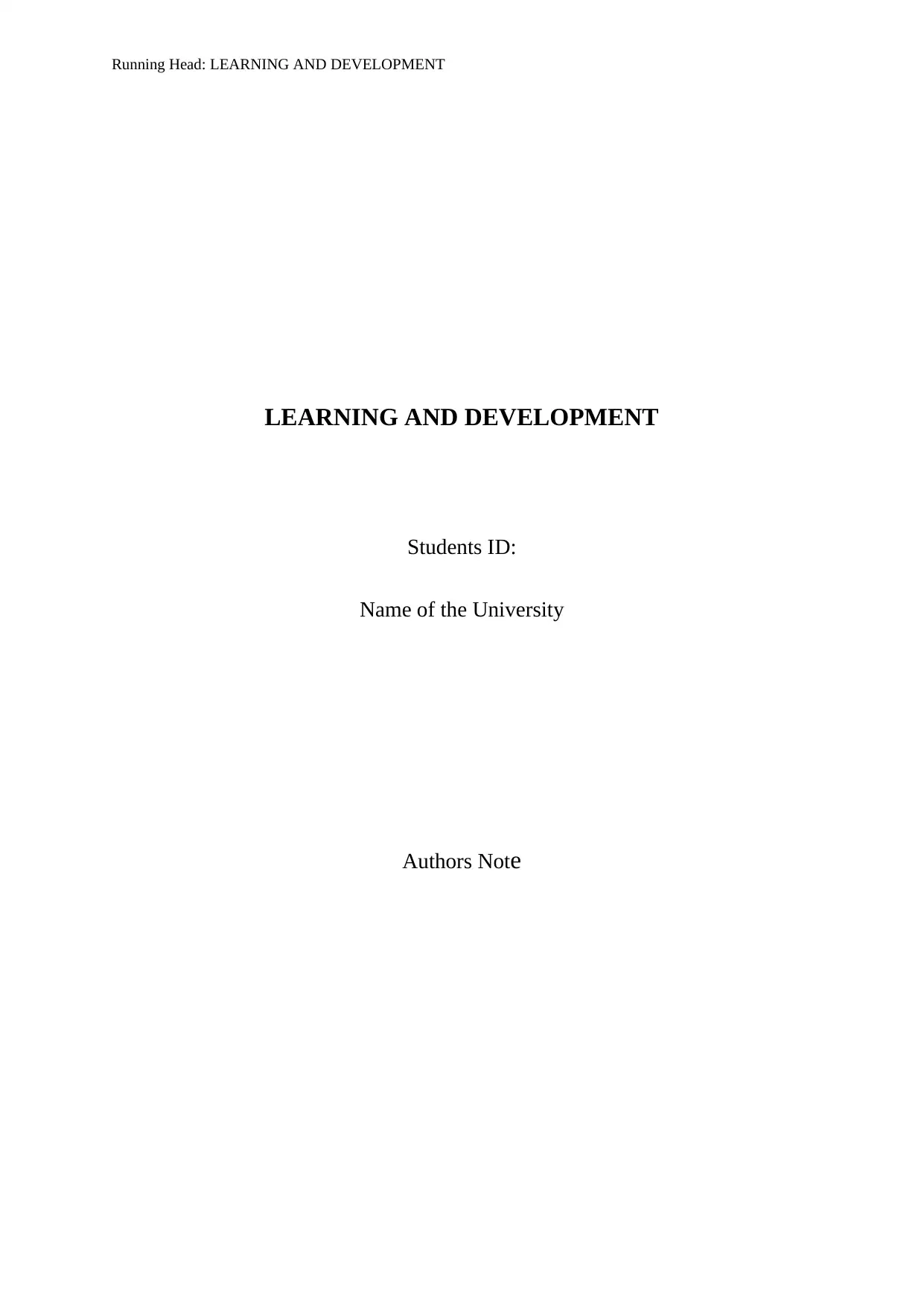
Running Head: LEARNING AND DEVELOPMENT
LEARNING AND DEVELOPMENT
Students ID:
Name of the University
Authors Note
LEARNING AND DEVELOPMENT
Students ID:
Name of the University
Authors Note
Paraphrase This Document
Need a fresh take? Get an instant paraphrase of this document with our AI Paraphraser
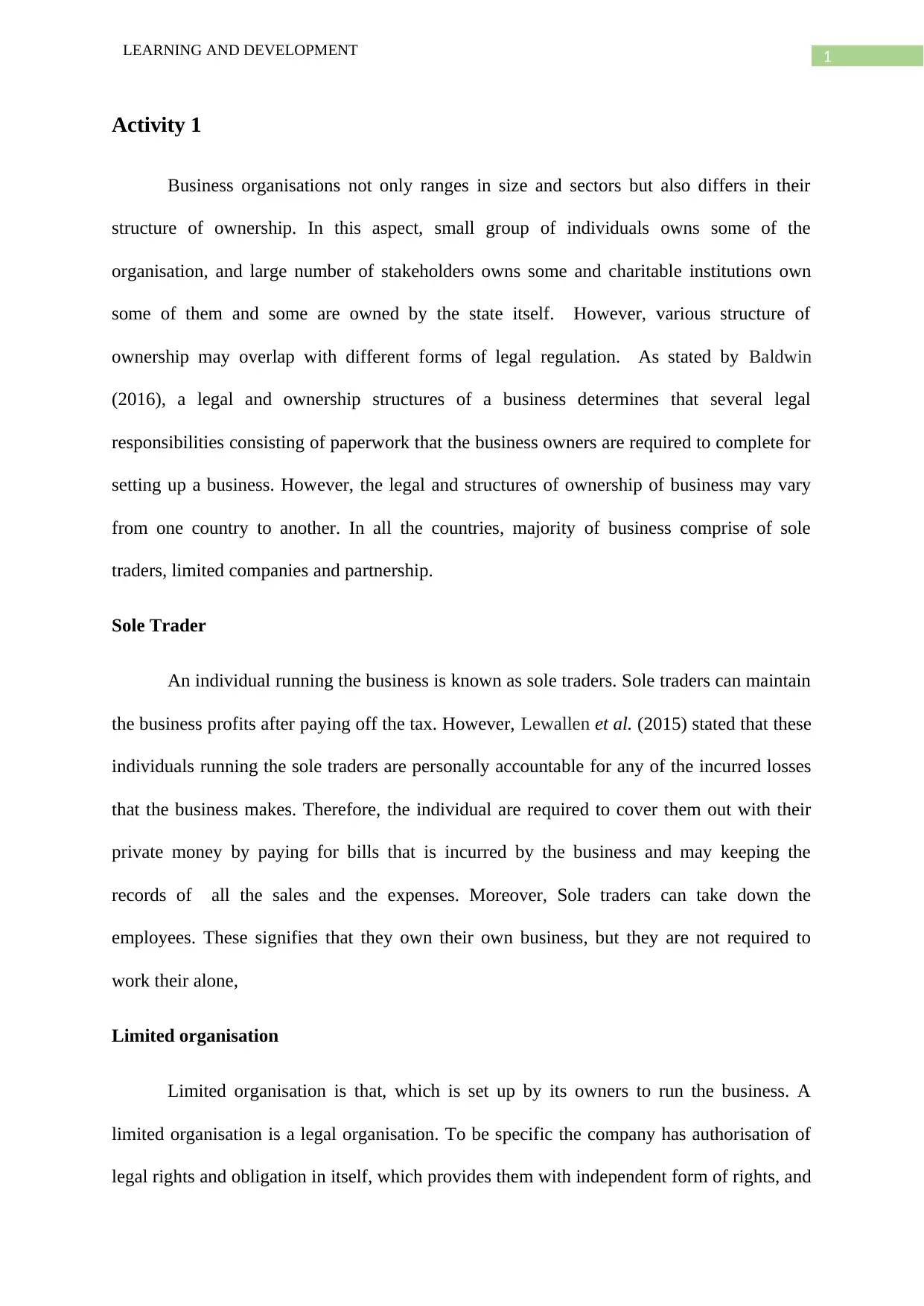
1LEARNING AND DEVELOPMENT
Activity 1
Business organisations not only ranges in size and sectors but also differs in their
structure of ownership. In this aspect, small group of individuals owns some of the
organisation, and large number of stakeholders owns some and charitable institutions own
some of them and some are owned by the state itself. However, various structure of
ownership may overlap with different forms of legal regulation. As stated by Baldwin
(2016), a legal and ownership structures of a business determines that several legal
responsibilities consisting of paperwork that the business owners are required to complete for
setting up a business. However, the legal and structures of ownership of business may vary
from one country to another. In all the countries, majority of business comprise of sole
traders, limited companies and partnership.
Sole Trader
An individual running the business is known as sole traders. Sole traders can maintain
the business profits after paying off the tax. However, Lewallen et al. (2015) stated that these
individuals running the sole traders are personally accountable for any of the incurred losses
that the business makes. Therefore, the individual are required to cover them out with their
private money by paying for bills that is incurred by the business and may keeping the
records of all the sales and the expenses. Moreover, Sole traders can take down the
employees. These signifies that they own their own business, but they are not required to
work their alone,
Limited organisation
Limited organisation is that, which is set up by its owners to run the business. A
limited organisation is a legal organisation. To be specific the company has authorisation of
legal rights and obligation in itself, which provides them with independent form of rights, and
Activity 1
Business organisations not only ranges in size and sectors but also differs in their
structure of ownership. In this aspect, small group of individuals owns some of the
organisation, and large number of stakeholders owns some and charitable institutions own
some of them and some are owned by the state itself. However, various structure of
ownership may overlap with different forms of legal regulation. As stated by Baldwin
(2016), a legal and ownership structures of a business determines that several legal
responsibilities consisting of paperwork that the business owners are required to complete for
setting up a business. However, the legal and structures of ownership of business may vary
from one country to another. In all the countries, majority of business comprise of sole
traders, limited companies and partnership.
Sole Trader
An individual running the business is known as sole traders. Sole traders can maintain
the business profits after paying off the tax. However, Lewallen et al. (2015) stated that these
individuals running the sole traders are personally accountable for any of the incurred losses
that the business makes. Therefore, the individual are required to cover them out with their
private money by paying for bills that is incurred by the business and may keeping the
records of all the sales and the expenses. Moreover, Sole traders can take down the
employees. These signifies that they own their own business, but they are not required to
work their alone,
Limited organisation
Limited organisation is that, which is set up by its owners to run the business. A
limited organisation is a legal organisation. To be specific the company has authorisation of
legal rights and obligation in itself, which provides them with independent form of rights, and
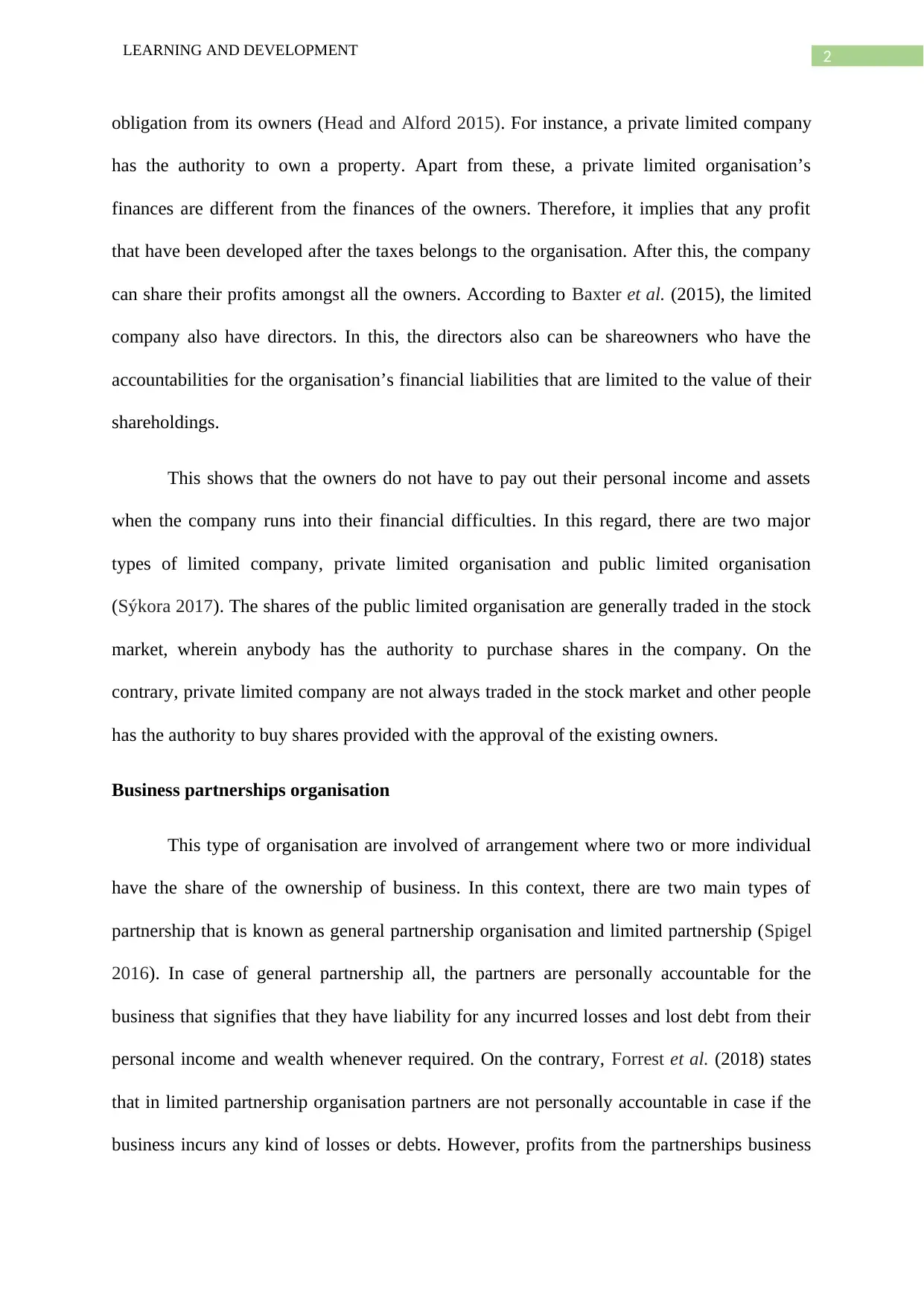
2LEARNING AND DEVELOPMENT
obligation from its owners (Head and Alford 2015). For instance, a private limited company
has the authority to own a property. Apart from these, a private limited organisation’s
finances are different from the finances of the owners. Therefore, it implies that any profit
that have been developed after the taxes belongs to the organisation. After this, the company
can share their profits amongst all the owners. According to Baxter et al. (2015), the limited
company also have directors. In this, the directors also can be shareowners who have the
accountabilities for the organisation’s financial liabilities that are limited to the value of their
shareholdings.
This shows that the owners do not have to pay out their personal income and assets
when the company runs into their financial difficulties. In this regard, there are two major
types of limited company, private limited organisation and public limited organisation
(Sýkora 2017). The shares of the public limited organisation are generally traded in the stock
market, wherein anybody has the authority to purchase shares in the company. On the
contrary, private limited company are not always traded in the stock market and other people
has the authority to buy shares provided with the approval of the existing owners.
Business partnerships organisation
This type of organisation are involved of arrangement where two or more individual
have the share of the ownership of business. In this context, there are two main types of
partnership that is known as general partnership organisation and limited partnership (Spigel
2016). In case of general partnership all, the partners are personally accountable for the
business that signifies that they have liability for any incurred losses and lost debt from their
personal income and wealth whenever required. On the contrary, Forrest et al. (2018) states
that in limited partnership organisation partners are not personally accountable in case if the
business incurs any kind of losses or debts. However, profits from the partnerships business
obligation from its owners (Head and Alford 2015). For instance, a private limited company
has the authority to own a property. Apart from these, a private limited organisation’s
finances are different from the finances of the owners. Therefore, it implies that any profit
that have been developed after the taxes belongs to the organisation. After this, the company
can share their profits amongst all the owners. According to Baxter et al. (2015), the limited
company also have directors. In this, the directors also can be shareowners who have the
accountabilities for the organisation’s financial liabilities that are limited to the value of their
shareholdings.
This shows that the owners do not have to pay out their personal income and assets
when the company runs into their financial difficulties. In this regard, there are two major
types of limited company, private limited organisation and public limited organisation
(Sýkora 2017). The shares of the public limited organisation are generally traded in the stock
market, wherein anybody has the authority to purchase shares in the company. On the
contrary, private limited company are not always traded in the stock market and other people
has the authority to buy shares provided with the approval of the existing owners.
Business partnerships organisation
This type of organisation are involved of arrangement where two or more individual
have the share of the ownership of business. In this context, there are two main types of
partnership that is known as general partnership organisation and limited partnership (Spigel
2016). In case of general partnership all, the partners are personally accountable for the
business that signifies that they have liability for any incurred losses and lost debt from their
personal income and wealth whenever required. On the contrary, Forrest et al. (2018) states
that in limited partnership organisation partners are not personally accountable in case if the
business incurs any kind of losses or debts. However, profits from the partnerships business
⊘ This is a preview!⊘
Do you want full access?
Subscribe today to unlock all pages.

Trusted by 1+ million students worldwide
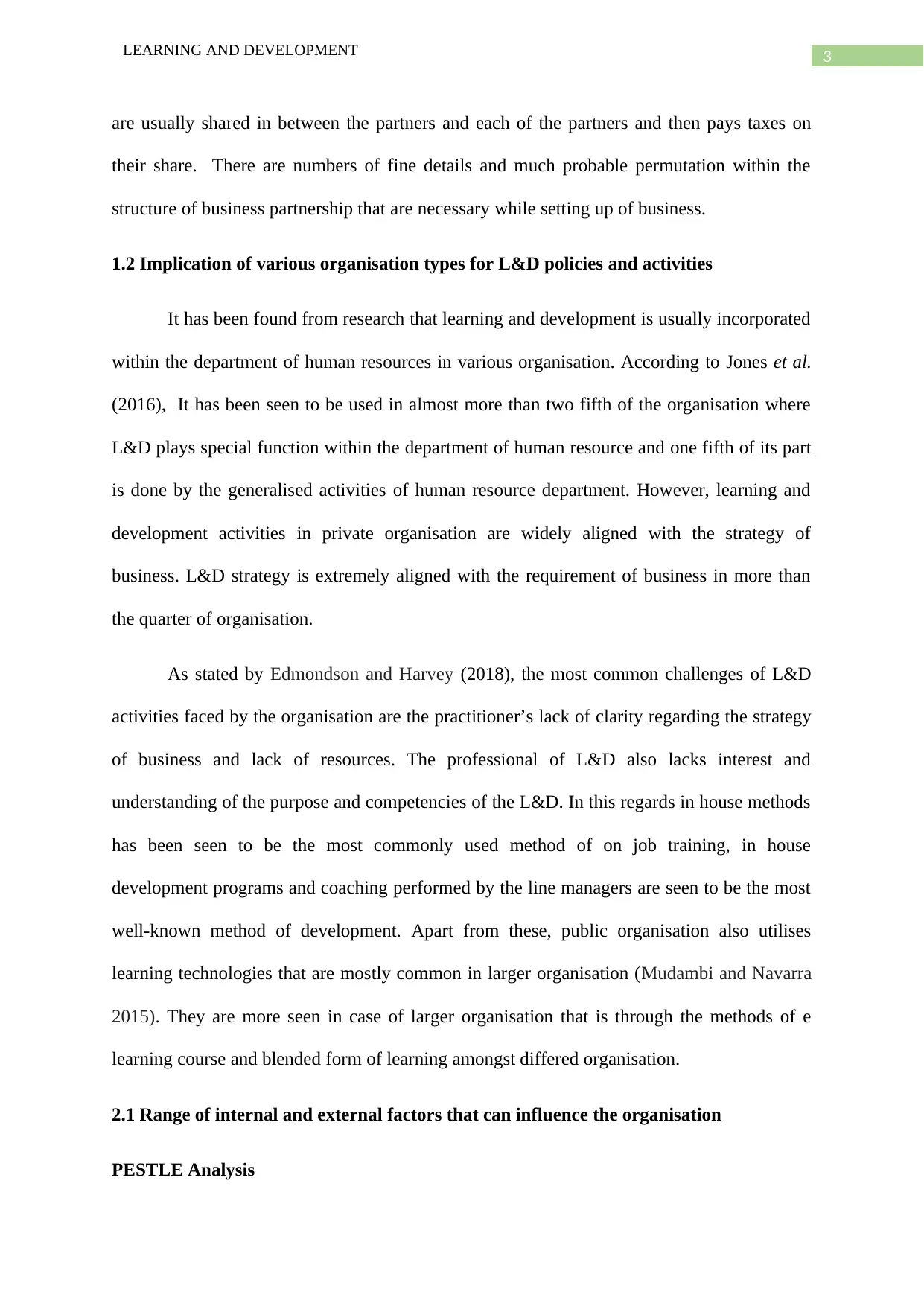
3LEARNING AND DEVELOPMENT
are usually shared in between the partners and each of the partners and then pays taxes on
their share. There are numbers of fine details and much probable permutation within the
structure of business partnership that are necessary while setting up of business.
1.2 Implication of various organisation types for L&D policies and activities
It has been found from research that learning and development is usually incorporated
within the department of human resources in various organisation. According to Jones et al.
(2016), It has been seen to be used in almost more than two fifth of the organisation where
L&D plays special function within the department of human resource and one fifth of its part
is done by the generalised activities of human resource department. However, learning and
development activities in private organisation are widely aligned with the strategy of
business. L&D strategy is extremely aligned with the requirement of business in more than
the quarter of organisation.
As stated by Edmondson and Harvey (2018), the most common challenges of L&D
activities faced by the organisation are the practitioner’s lack of clarity regarding the strategy
of business and lack of resources. The professional of L&D also lacks interest and
understanding of the purpose and competencies of the L&D. In this regards in house methods
has been seen to be the most commonly used method of on job training, in house
development programs and coaching performed by the line managers are seen to be the most
well-known method of development. Apart from these, public organisation also utilises
learning technologies that are mostly common in larger organisation (Mudambi and Navarra
2015). They are more seen in case of larger organisation that is through the methods of e
learning course and blended form of learning amongst differed organisation.
2.1 Range of internal and external factors that can influence the organisation
PESTLE Analysis
are usually shared in between the partners and each of the partners and then pays taxes on
their share. There are numbers of fine details and much probable permutation within the
structure of business partnership that are necessary while setting up of business.
1.2 Implication of various organisation types for L&D policies and activities
It has been found from research that learning and development is usually incorporated
within the department of human resources in various organisation. According to Jones et al.
(2016), It has been seen to be used in almost more than two fifth of the organisation where
L&D plays special function within the department of human resource and one fifth of its part
is done by the generalised activities of human resource department. However, learning and
development activities in private organisation are widely aligned with the strategy of
business. L&D strategy is extremely aligned with the requirement of business in more than
the quarter of organisation.
As stated by Edmondson and Harvey (2018), the most common challenges of L&D
activities faced by the organisation are the practitioner’s lack of clarity regarding the strategy
of business and lack of resources. The professional of L&D also lacks interest and
understanding of the purpose and competencies of the L&D. In this regards in house methods
has been seen to be the most commonly used method of on job training, in house
development programs and coaching performed by the line managers are seen to be the most
well-known method of development. Apart from these, public organisation also utilises
learning technologies that are mostly common in larger organisation (Mudambi and Navarra
2015). They are more seen in case of larger organisation that is through the methods of e
learning course and blended form of learning amongst differed organisation.
2.1 Range of internal and external factors that can influence the organisation
PESTLE Analysis
Paraphrase This Document
Need a fresh take? Get an instant paraphrase of this document with our AI Paraphraser
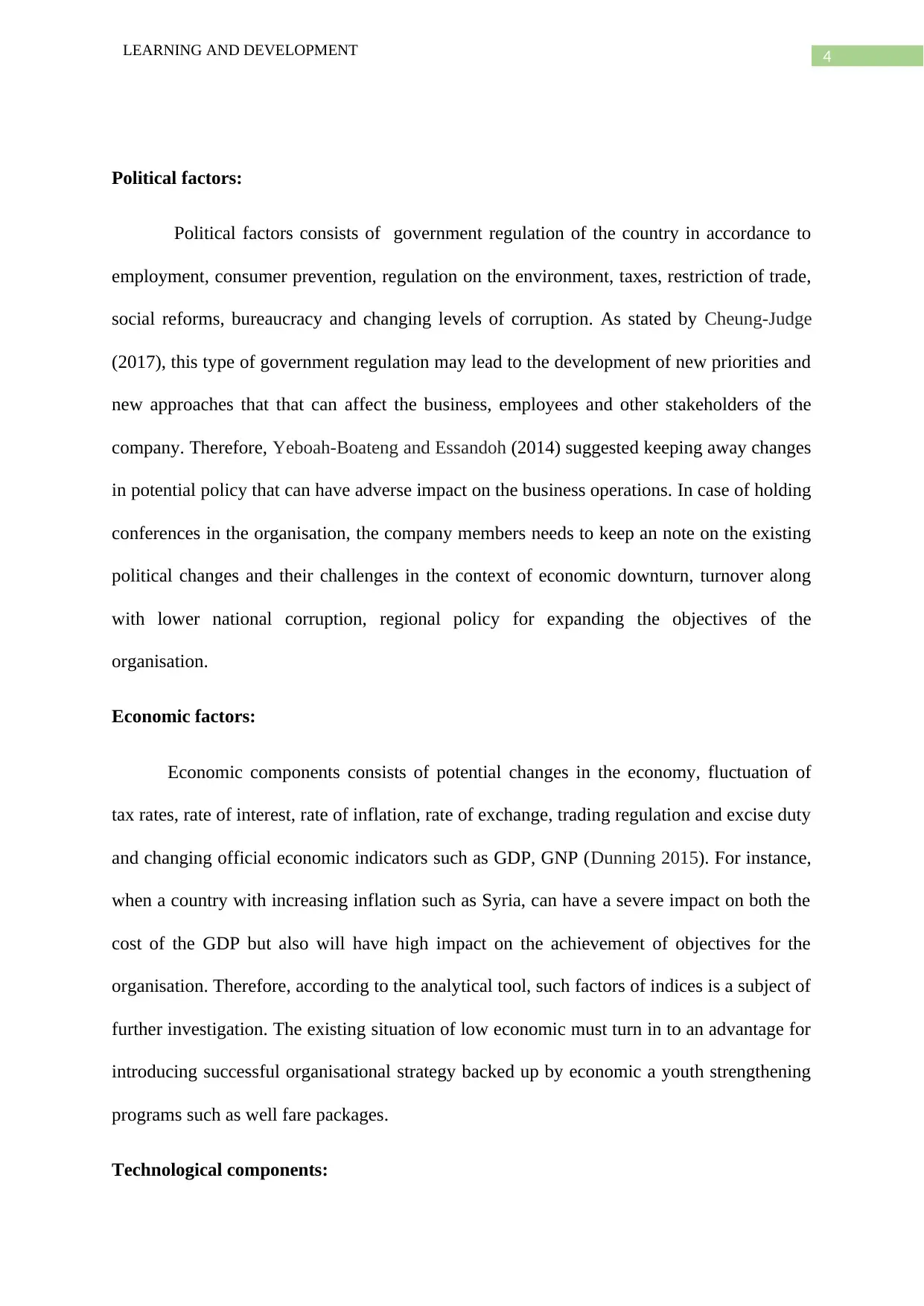
4LEARNING AND DEVELOPMENT
Political factors:
Political factors consists of government regulation of the country in accordance to
employment, consumer prevention, regulation on the environment, taxes, restriction of trade,
social reforms, bureaucracy and changing levels of corruption. As stated by Cheung-Judge
(2017), this type of government regulation may lead to the development of new priorities and
new approaches that that can affect the business, employees and other stakeholders of the
company. Therefore, Yeboah-Boateng and Essandoh (2014) suggested keeping away changes
in potential policy that can have adverse impact on the business operations. In case of holding
conferences in the organisation, the company members needs to keep an note on the existing
political changes and their challenges in the context of economic downturn, turnover along
with lower national corruption, regional policy for expanding the objectives of the
organisation.
Economic factors:
Economic components consists of potential changes in the economy, fluctuation of
tax rates, rate of interest, rate of inflation, rate of exchange, trading regulation and excise duty
and changing official economic indicators such as GDP, GNP (Dunning 2015). For instance,
when a country with increasing inflation such as Syria, can have a severe impact on both the
cost of the GDP but also will have high impact on the achievement of objectives for the
organisation. Therefore, according to the analytical tool, such factors of indices is a subject of
further investigation. The existing situation of low economic must turn in to an advantage for
introducing successful organisational strategy backed up by economic a youth strengthening
programs such as well fare packages.
Technological components:
Political factors:
Political factors consists of government regulation of the country in accordance to
employment, consumer prevention, regulation on the environment, taxes, restriction of trade,
social reforms, bureaucracy and changing levels of corruption. As stated by Cheung-Judge
(2017), this type of government regulation may lead to the development of new priorities and
new approaches that that can affect the business, employees and other stakeholders of the
company. Therefore, Yeboah-Boateng and Essandoh (2014) suggested keeping away changes
in potential policy that can have adverse impact on the business operations. In case of holding
conferences in the organisation, the company members needs to keep an note on the existing
political changes and their challenges in the context of economic downturn, turnover along
with lower national corruption, regional policy for expanding the objectives of the
organisation.
Economic factors:
Economic components consists of potential changes in the economy, fluctuation of
tax rates, rate of interest, rate of inflation, rate of exchange, trading regulation and excise duty
and changing official economic indicators such as GDP, GNP (Dunning 2015). For instance,
when a country with increasing inflation such as Syria, can have a severe impact on both the
cost of the GDP but also will have high impact on the achievement of objectives for the
organisation. Therefore, according to the analytical tool, such factors of indices is a subject of
further investigation. The existing situation of low economic must turn in to an advantage for
introducing successful organisational strategy backed up by economic a youth strengthening
programs such as well fare packages.
Technological components:
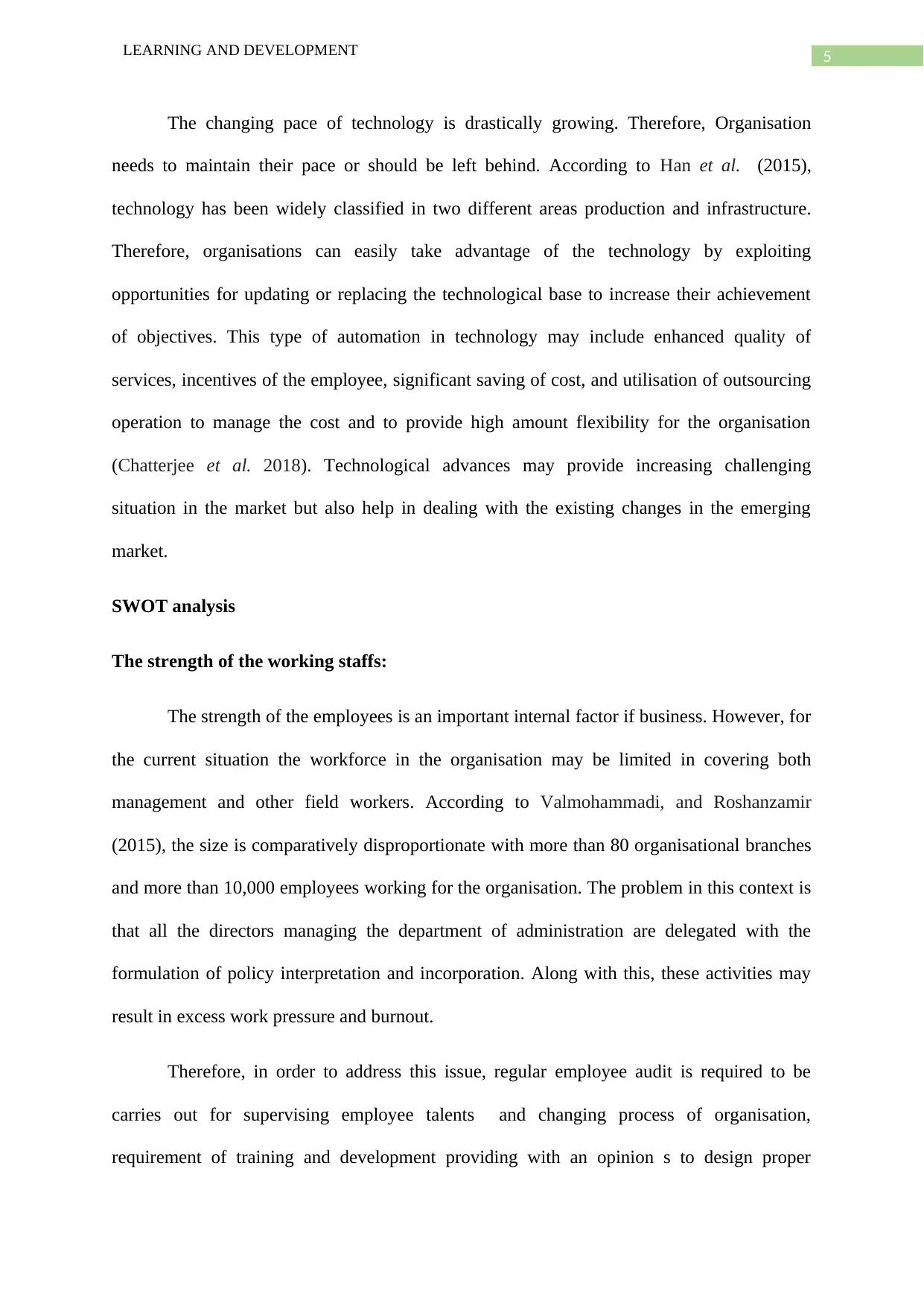
5LEARNING AND DEVELOPMENT
The changing pace of technology is drastically growing. Therefore, Organisation
needs to maintain their pace or should be left behind. According to Han et al. (2015),
technology has been widely classified in two different areas production and infrastructure.
Therefore, organisations can easily take advantage of the technology by exploiting
opportunities for updating or replacing the technological base to increase their achievement
of objectives. This type of automation in technology may include enhanced quality of
services, incentives of the employee, significant saving of cost, and utilisation of outsourcing
operation to manage the cost and to provide high amount flexibility for the organisation
(Chatterjee et al. 2018). Technological advances may provide increasing challenging
situation in the market but also help in dealing with the existing changes in the emerging
market.
SWOT analysis
The strength of the working staffs:
The strength of the employees is an important internal factor if business. However, for
the current situation the workforce in the organisation may be limited in covering both
management and other field workers. According to Valmohammadi, and Roshanzamir
(2015), the size is comparatively disproportionate with more than 80 organisational branches
and more than 10,000 employees working for the organisation. The problem in this context is
that all the directors managing the department of administration are delegated with the
formulation of policy interpretation and incorporation. Along with this, these activities may
result in excess work pressure and burnout.
Therefore, in order to address this issue, regular employee audit is required to be
carries out for supervising employee talents and changing process of organisation,
requirement of training and development providing with an opinion s to design proper
The changing pace of technology is drastically growing. Therefore, Organisation
needs to maintain their pace or should be left behind. According to Han et al. (2015),
technology has been widely classified in two different areas production and infrastructure.
Therefore, organisations can easily take advantage of the technology by exploiting
opportunities for updating or replacing the technological base to increase their achievement
of objectives. This type of automation in technology may include enhanced quality of
services, incentives of the employee, significant saving of cost, and utilisation of outsourcing
operation to manage the cost and to provide high amount flexibility for the organisation
(Chatterjee et al. 2018). Technological advances may provide increasing challenging
situation in the market but also help in dealing with the existing changes in the emerging
market.
SWOT analysis
The strength of the working staffs:
The strength of the employees is an important internal factor if business. However, for
the current situation the workforce in the organisation may be limited in covering both
management and other field workers. According to Valmohammadi, and Roshanzamir
(2015), the size is comparatively disproportionate with more than 80 organisational branches
and more than 10,000 employees working for the organisation. The problem in this context is
that all the directors managing the department of administration are delegated with the
formulation of policy interpretation and incorporation. Along with this, these activities may
result in excess work pressure and burnout.
Therefore, in order to address this issue, regular employee audit is required to be
carries out for supervising employee talents and changing process of organisation,
requirement of training and development providing with an opinion s to design proper
⊘ This is a preview!⊘
Do you want full access?
Subscribe today to unlock all pages.

Trusted by 1+ million students worldwide
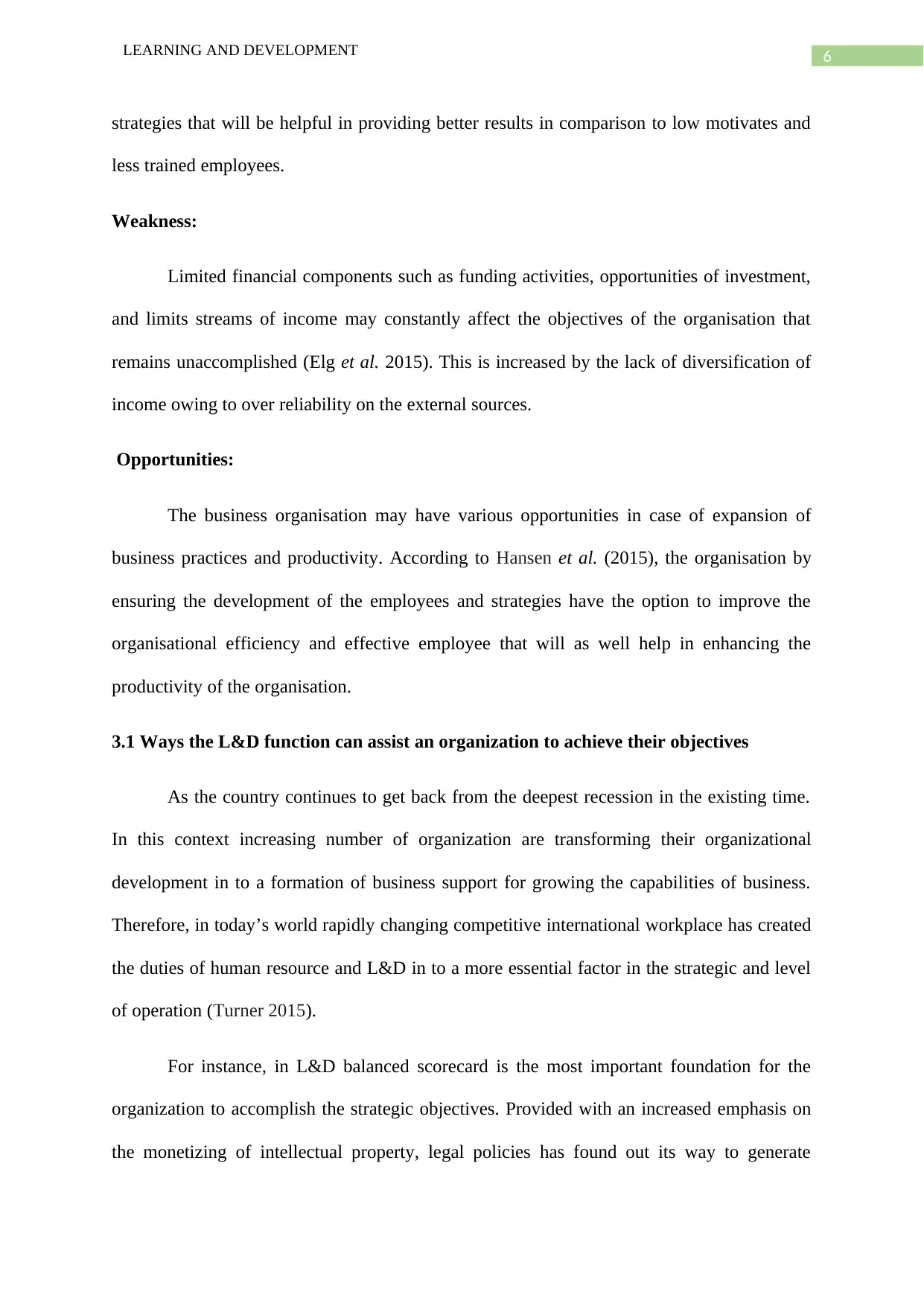
6LEARNING AND DEVELOPMENT
strategies that will be helpful in providing better results in comparison to low motivates and
less trained employees.
Weakness:
Limited financial components such as funding activities, opportunities of investment,
and limits streams of income may constantly affect the objectives of the organisation that
remains unaccomplished (Elg et al. 2015). This is increased by the lack of diversification of
income owing to over reliability on the external sources.
Opportunities:
The business organisation may have various opportunities in case of expansion of
business practices and productivity. According to Hansen et al. (2015), the organisation by
ensuring the development of the employees and strategies have the option to improve the
organisational efficiency and effective employee that will as well help in enhancing the
productivity of the organisation.
3.1 Ways the L&D function can assist an organization to achieve their objectives
As the country continues to get back from the deepest recession in the existing time.
In this context increasing number of organization are transforming their organizational
development in to a formation of business support for growing the capabilities of business.
Therefore, in today’s world rapidly changing competitive international workplace has created
the duties of human resource and L&D in to a more essential factor in the strategic and level
of operation (Turner 2015).
For instance, in L&D balanced scorecard is the most important foundation for the
organization to accomplish the strategic objectives. Provided with an increased emphasis on
the monetizing of intellectual property, legal policies has found out its way to generate
strategies that will be helpful in providing better results in comparison to low motivates and
less trained employees.
Weakness:
Limited financial components such as funding activities, opportunities of investment,
and limits streams of income may constantly affect the objectives of the organisation that
remains unaccomplished (Elg et al. 2015). This is increased by the lack of diversification of
income owing to over reliability on the external sources.
Opportunities:
The business organisation may have various opportunities in case of expansion of
business practices and productivity. According to Hansen et al. (2015), the organisation by
ensuring the development of the employees and strategies have the option to improve the
organisational efficiency and effective employee that will as well help in enhancing the
productivity of the organisation.
3.1 Ways the L&D function can assist an organization to achieve their objectives
As the country continues to get back from the deepest recession in the existing time.
In this context increasing number of organization are transforming their organizational
development in to a formation of business support for growing the capabilities of business.
Therefore, in today’s world rapidly changing competitive international workplace has created
the duties of human resource and L&D in to a more essential factor in the strategic and level
of operation (Turner 2015).
For instance, in L&D balanced scorecard is the most important foundation for the
organization to accomplish the strategic objectives. Provided with an increased emphasis on
the monetizing of intellectual property, legal policies has found out its way to generate
Paraphrase This Document
Need a fresh take? Get an instant paraphrase of this document with our AI Paraphraser
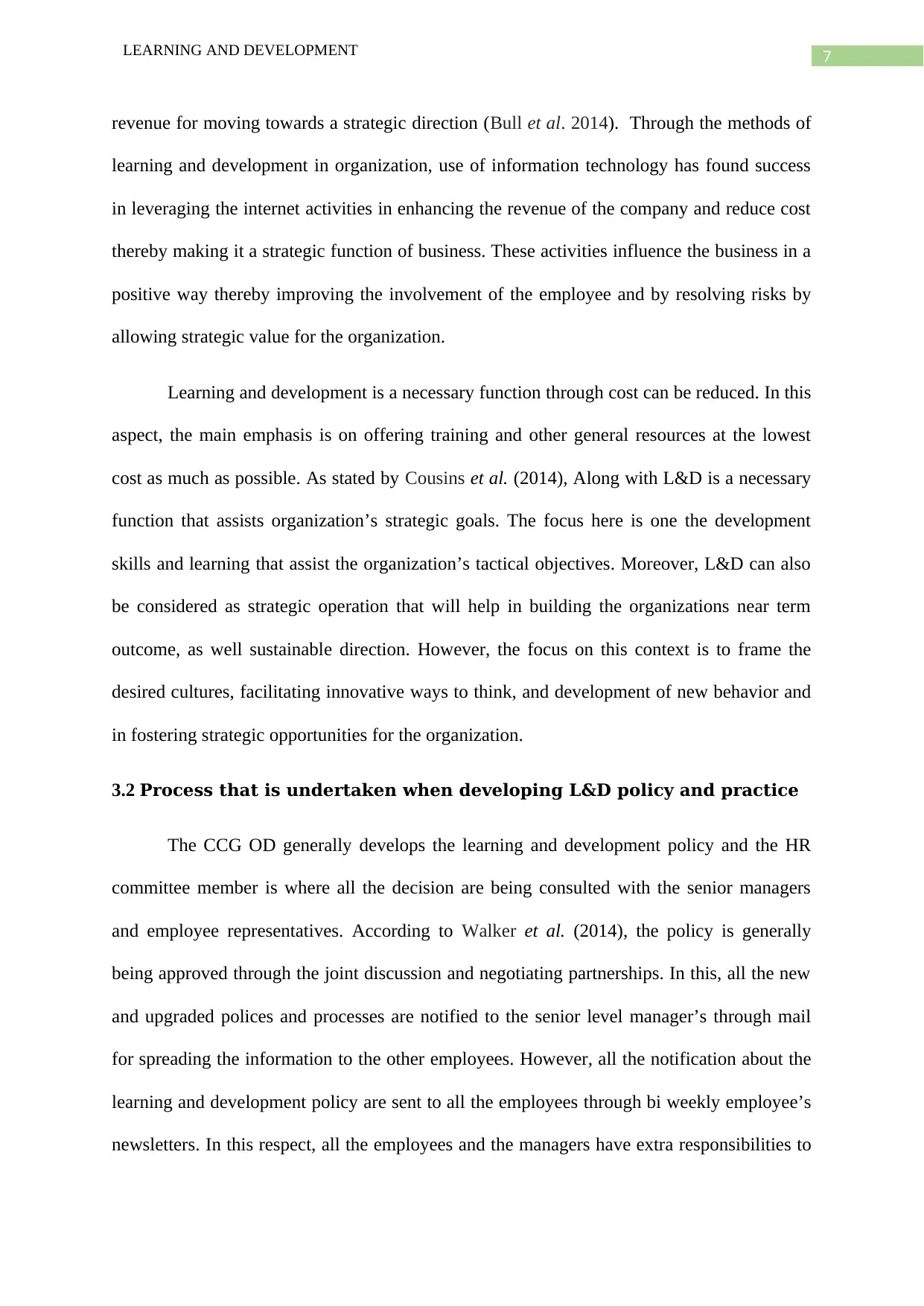
7LEARNING AND DEVELOPMENT
revenue for moving towards a strategic direction (Bull et al. 2014). Through the methods of
learning and development in organization, use of information technology has found success
in leveraging the internet activities in enhancing the revenue of the company and reduce cost
thereby making it a strategic function of business. These activities influence the business in a
positive way thereby improving the involvement of the employee and by resolving risks by
allowing strategic value for the organization.
Learning and development is a necessary function through cost can be reduced. In this
aspect, the main emphasis is on offering training and other general resources at the lowest
cost as much as possible. As stated by Cousins et al. (2014), Along with L&D is a necessary
function that assists organization’s strategic goals. The focus here is one the development
skills and learning that assist the organization’s tactical objectives. Moreover, L&D can also
be considered as strategic operation that will help in building the organizations near term
outcome, as well sustainable direction. However, the focus on this context is to frame the
desired cultures, facilitating innovative ways to think, and development of new behavior and
in fostering strategic opportunities for the organization.
3.2 Process that is undertaken when developing L&D policy and practice
The CCG OD generally develops the learning and development policy and the HR
committee member is where all the decision are being consulted with the senior managers
and employee representatives. According to Walker et al. (2014), the policy is generally
being approved through the joint discussion and negotiating partnerships. In this, all the new
and upgraded polices and processes are notified to the senior level manager’s through mail
for spreading the information to the other employees. However, all the notification about the
learning and development policy are sent to all the employees through bi weekly employee’s
newsletters. In this respect, all the employees and the managers have extra responsibilities to
revenue for moving towards a strategic direction (Bull et al. 2014). Through the methods of
learning and development in organization, use of information technology has found success
in leveraging the internet activities in enhancing the revenue of the company and reduce cost
thereby making it a strategic function of business. These activities influence the business in a
positive way thereby improving the involvement of the employee and by resolving risks by
allowing strategic value for the organization.
Learning and development is a necessary function through cost can be reduced. In this
aspect, the main emphasis is on offering training and other general resources at the lowest
cost as much as possible. As stated by Cousins et al. (2014), Along with L&D is a necessary
function that assists organization’s strategic goals. The focus here is one the development
skills and learning that assist the organization’s tactical objectives. Moreover, L&D can also
be considered as strategic operation that will help in building the organizations near term
outcome, as well sustainable direction. However, the focus on this context is to frame the
desired cultures, facilitating innovative ways to think, and development of new behavior and
in fostering strategic opportunities for the organization.
3.2 Process that is undertaken when developing L&D policy and practice
The CCG OD generally develops the learning and development policy and the HR
committee member is where all the decision are being consulted with the senior managers
and employee representatives. According to Walker et al. (2014), the policy is generally
being approved through the joint discussion and negotiating partnerships. In this, all the new
and upgraded polices and processes are notified to the senior level manager’s through mail
for spreading the information to the other employees. However, all the notification about the
learning and development policy are sent to all the employees through bi weekly employee’s
newsletters. In this respect, all the employees and the managers have extra responsibilities to
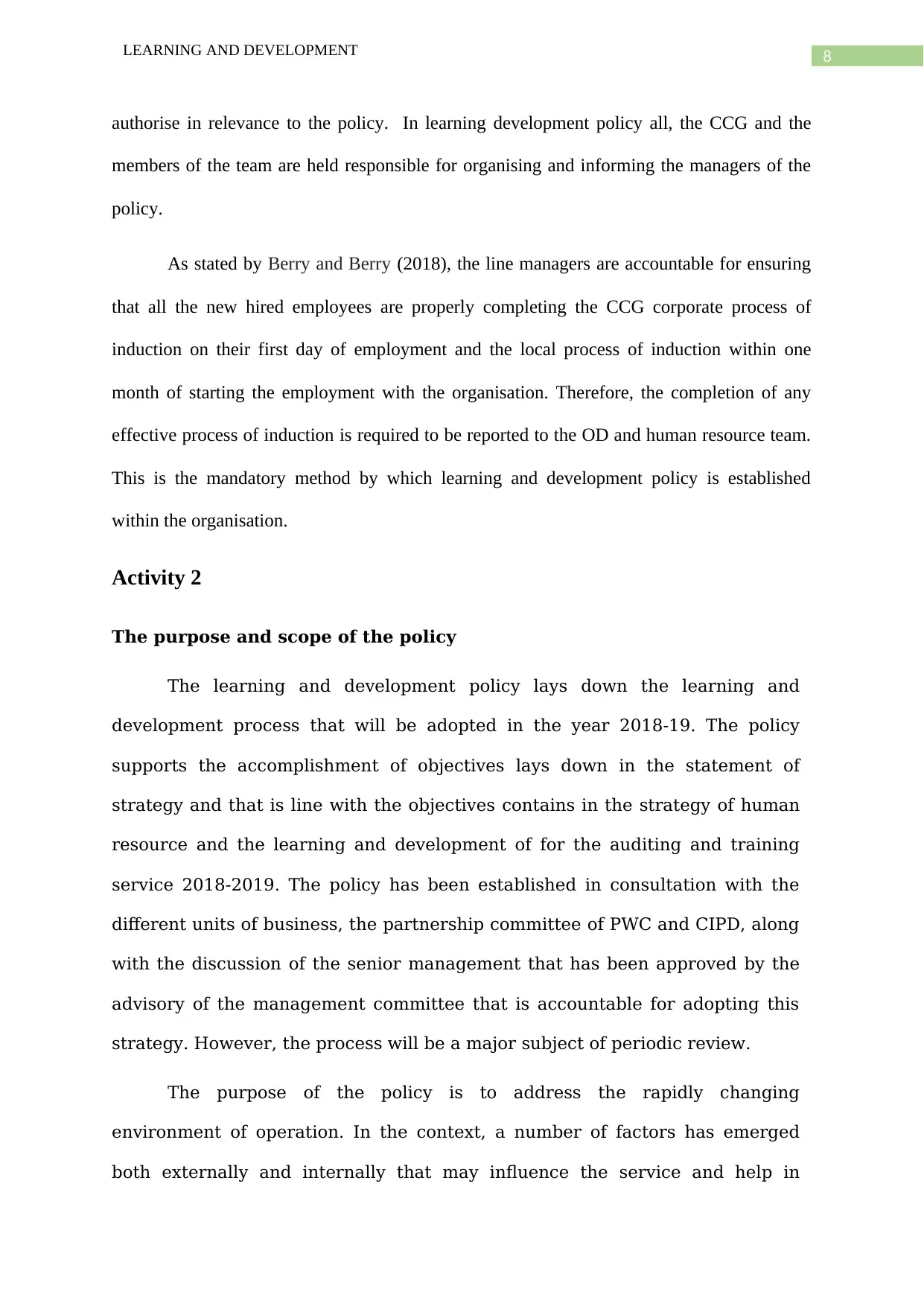
8LEARNING AND DEVELOPMENT
authorise in relevance to the policy. In learning development policy all, the CCG and the
members of the team are held responsible for organising and informing the managers of the
policy.
As stated by Berry and Berry (2018), the line managers are accountable for ensuring
that all the new hired employees are properly completing the CCG corporate process of
induction on their first day of employment and the local process of induction within one
month of starting the employment with the organisation. Therefore, the completion of any
effective process of induction is required to be reported to the OD and human resource team.
This is the mandatory method by which learning and development policy is established
within the organisation.
Activity 2
The purpose and scope of the policy
The learning and development policy lays down the learning and
development process that will be adopted in the year 2018-19. The policy
supports the accomplishment of objectives lays down in the statement of
strategy and that is line with the objectives contains in the strategy of human
resource and the learning and development of for the auditing and training
service 2018-2019. The policy has been established in consultation with the
different units of business, the partnership committee of PWC and CIPD, along
with the discussion of the senior management that has been approved by the
advisory of the management committee that is accountable for adopting this
strategy. However, the process will be a major subject of periodic review.
The purpose of the policy is to address the rapidly changing
environment of operation. In the context, a number of factors has emerged
both externally and internally that may influence the service and help in
authorise in relevance to the policy. In learning development policy all, the CCG and the
members of the team are held responsible for organising and informing the managers of the
policy.
As stated by Berry and Berry (2018), the line managers are accountable for ensuring
that all the new hired employees are properly completing the CCG corporate process of
induction on their first day of employment and the local process of induction within one
month of starting the employment with the organisation. Therefore, the completion of any
effective process of induction is required to be reported to the OD and human resource team.
This is the mandatory method by which learning and development policy is established
within the organisation.
Activity 2
The purpose and scope of the policy
The learning and development policy lays down the learning and
development process that will be adopted in the year 2018-19. The policy
supports the accomplishment of objectives lays down in the statement of
strategy and that is line with the objectives contains in the strategy of human
resource and the learning and development of for the auditing and training
service 2018-2019. The policy has been established in consultation with the
different units of business, the partnership committee of PWC and CIPD, along
with the discussion of the senior management that has been approved by the
advisory of the management committee that is accountable for adopting this
strategy. However, the process will be a major subject of periodic review.
The purpose of the policy is to address the rapidly changing
environment of operation. In the context, a number of factors has emerged
both externally and internally that may influence the service and help in
⊘ This is a preview!⊘
Do you want full access?
Subscribe today to unlock all pages.

Trusted by 1+ million students worldwide
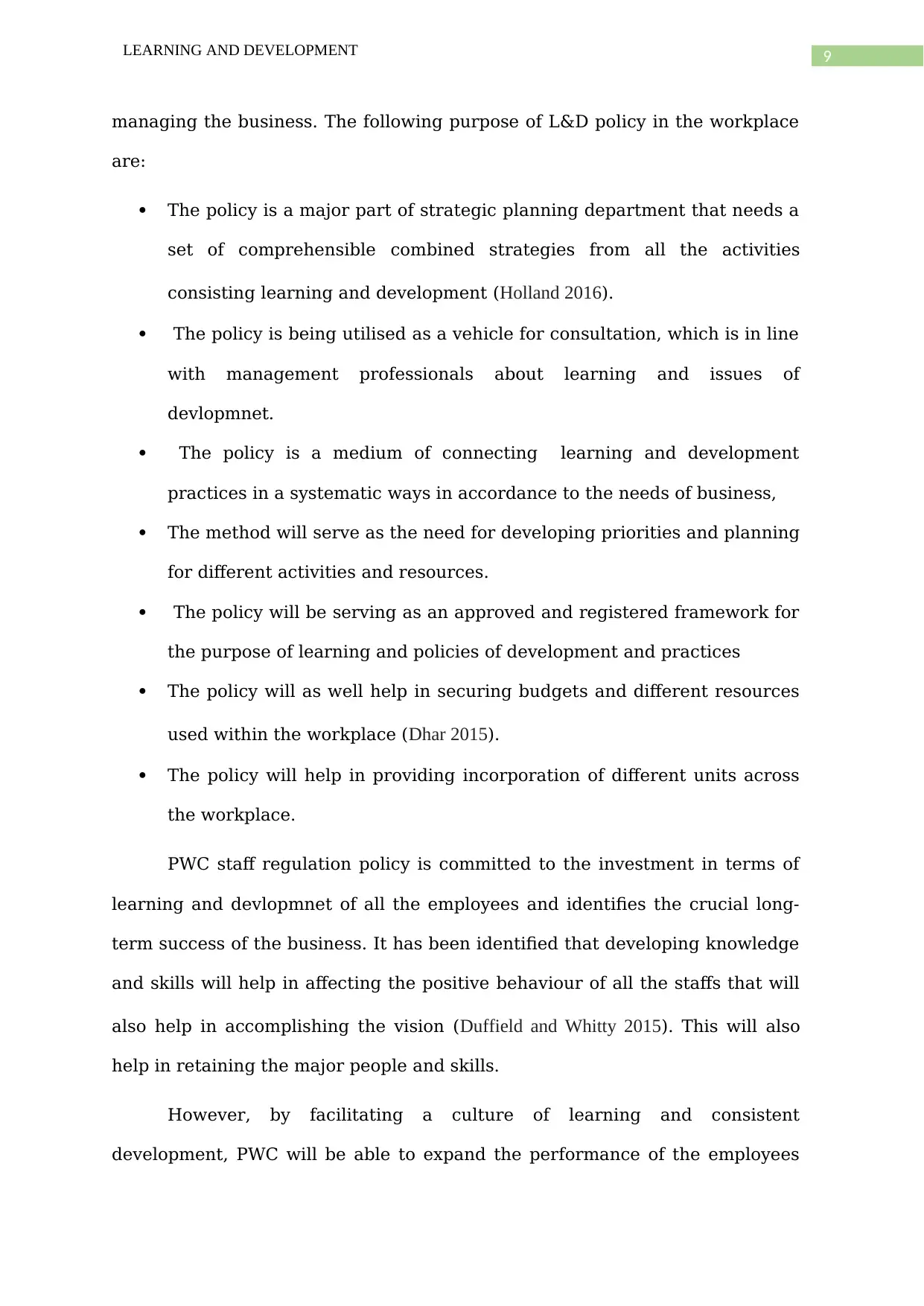
9LEARNING AND DEVELOPMENT
managing the business. The following purpose of L&D policy in the workplace
are:
The policy is a major part of strategic planning department that needs a
set of comprehensible combined strategies from all the activities
consisting learning and development (Holland 2016).
The policy is being utilised as a vehicle for consultation, which is in line
with management professionals about learning and issues of
devlopmnet.
The policy is a medium of connecting learning and development
practices in a systematic ways in accordance to the needs of business,
The method will serve as the need for developing priorities and planning
for different activities and resources.
The policy will be serving as an approved and registered framework for
the purpose of learning and policies of development and practices
The policy will as well help in securing budgets and different resources
used within the workplace (Dhar 2015).
The policy will help in providing incorporation of different units across
the workplace.
PWC staff regulation policy is committed to the investment in terms of
learning and devlopmnet of all the employees and identifies the crucial long-
term success of the business. It has been identified that developing knowledge
and skills will help in affecting the positive behaviour of all the staffs that will
also help in accomplishing the vision (Duffield and Whitty 2015). This will also
help in retaining the major people and skills.
However, by facilitating a culture of learning and consistent
development, PWC will be able to expand the performance of the employees
managing the business. The following purpose of L&D policy in the workplace
are:
The policy is a major part of strategic planning department that needs a
set of comprehensible combined strategies from all the activities
consisting learning and development (Holland 2016).
The policy is being utilised as a vehicle for consultation, which is in line
with management professionals about learning and issues of
devlopmnet.
The policy is a medium of connecting learning and development
practices in a systematic ways in accordance to the needs of business,
The method will serve as the need for developing priorities and planning
for different activities and resources.
The policy will be serving as an approved and registered framework for
the purpose of learning and policies of development and practices
The policy will as well help in securing budgets and different resources
used within the workplace (Dhar 2015).
The policy will help in providing incorporation of different units across
the workplace.
PWC staff regulation policy is committed to the investment in terms of
learning and devlopmnet of all the employees and identifies the crucial long-
term success of the business. It has been identified that developing knowledge
and skills will help in affecting the positive behaviour of all the staffs that will
also help in accomplishing the vision (Duffield and Whitty 2015). This will also
help in retaining the major people and skills.
However, by facilitating a culture of learning and consistent
development, PWC will be able to expand the performance of the employees
Paraphrase This Document
Need a fresh take? Get an instant paraphrase of this document with our AI Paraphraser
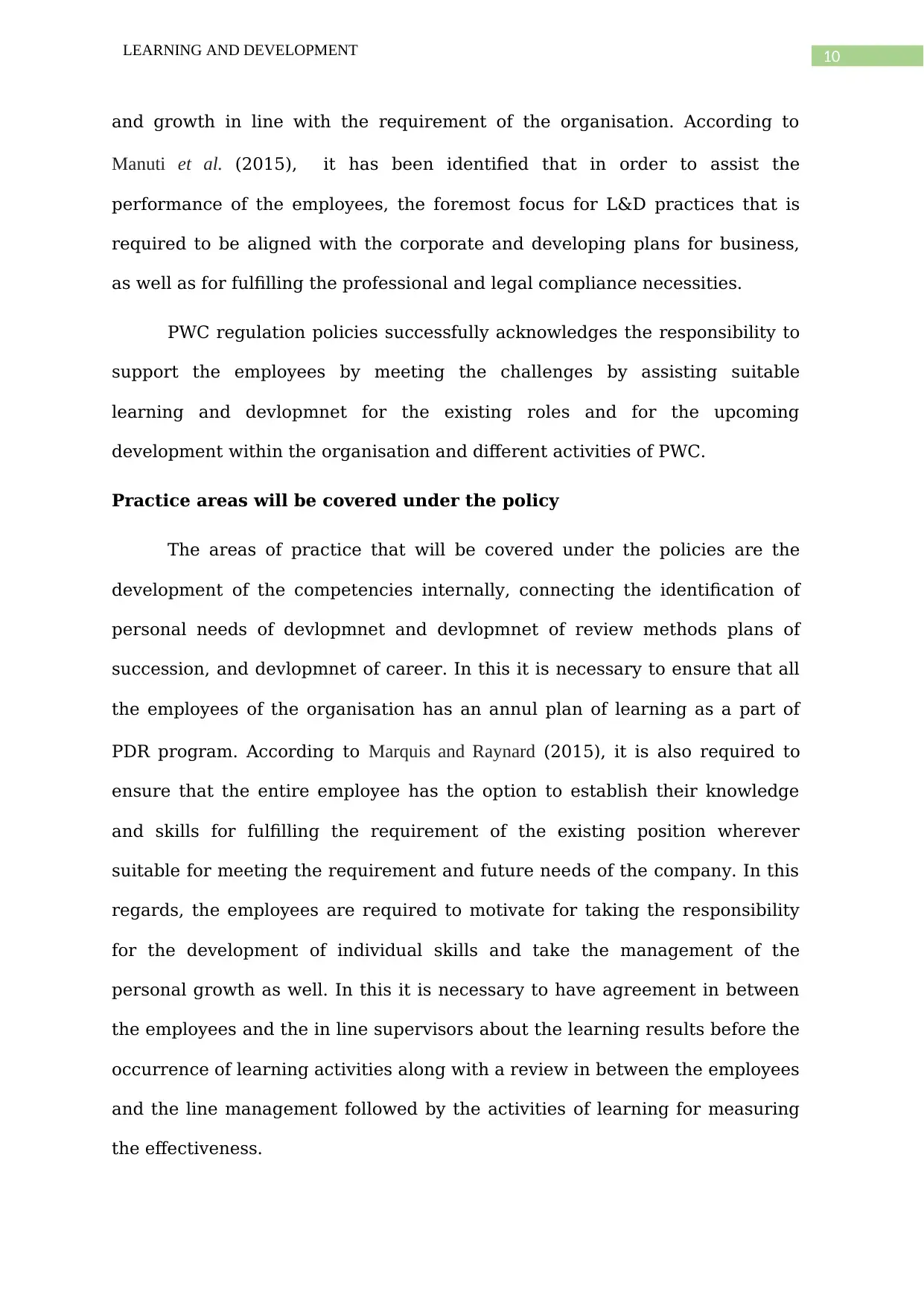
10LEARNING AND DEVELOPMENT
and growth in line with the requirement of the organisation. According to
Manuti et al. (2015), it has been identified that in order to assist the
performance of the employees, the foremost focus for L&D practices that is
required to be aligned with the corporate and developing plans for business,
as well as for fulfilling the professional and legal compliance necessities.
PWC regulation policies successfully acknowledges the responsibility to
support the employees by meeting the challenges by assisting suitable
learning and devlopmnet for the existing roles and for the upcoming
development within the organisation and different activities of PWC.
Practice areas will be covered under the policy
The areas of practice that will be covered under the policies are the
development of the competencies internally, connecting the identification of
personal needs of devlopmnet and devlopmnet of review methods plans of
succession, and devlopmnet of career. In this it is necessary to ensure that all
the employees of the organisation has an annul plan of learning as a part of
PDR program. According to Marquis and Raynard (2015), it is also required to
ensure that the entire employee has the option to establish their knowledge
and skills for fulfilling the requirement of the existing position wherever
suitable for meeting the requirement and future needs of the company. In this
regards, the employees are required to motivate for taking the responsibility
for the development of individual skills and take the management of the
personal growth as well. In this it is necessary to have agreement in between
the employees and the in line supervisors about the learning results before the
occurrence of learning activities along with a review in between the employees
and the line management followed by the activities of learning for measuring
the effectiveness.
and growth in line with the requirement of the organisation. According to
Manuti et al. (2015), it has been identified that in order to assist the
performance of the employees, the foremost focus for L&D practices that is
required to be aligned with the corporate and developing plans for business,
as well as for fulfilling the professional and legal compliance necessities.
PWC regulation policies successfully acknowledges the responsibility to
support the employees by meeting the challenges by assisting suitable
learning and devlopmnet for the existing roles and for the upcoming
development within the organisation and different activities of PWC.
Practice areas will be covered under the policy
The areas of practice that will be covered under the policies are the
development of the competencies internally, connecting the identification of
personal needs of devlopmnet and devlopmnet of review methods plans of
succession, and devlopmnet of career. In this it is necessary to ensure that all
the employees of the organisation has an annul plan of learning as a part of
PDR program. According to Marquis and Raynard (2015), it is also required to
ensure that the entire employee has the option to establish their knowledge
and skills for fulfilling the requirement of the existing position wherever
suitable for meeting the requirement and future needs of the company. In this
regards, the employees are required to motivate for taking the responsibility
for the development of individual skills and take the management of the
personal growth as well. In this it is necessary to have agreement in between
the employees and the in line supervisors about the learning results before the
occurrence of learning activities along with a review in between the employees
and the line management followed by the activities of learning for measuring
the effectiveness.
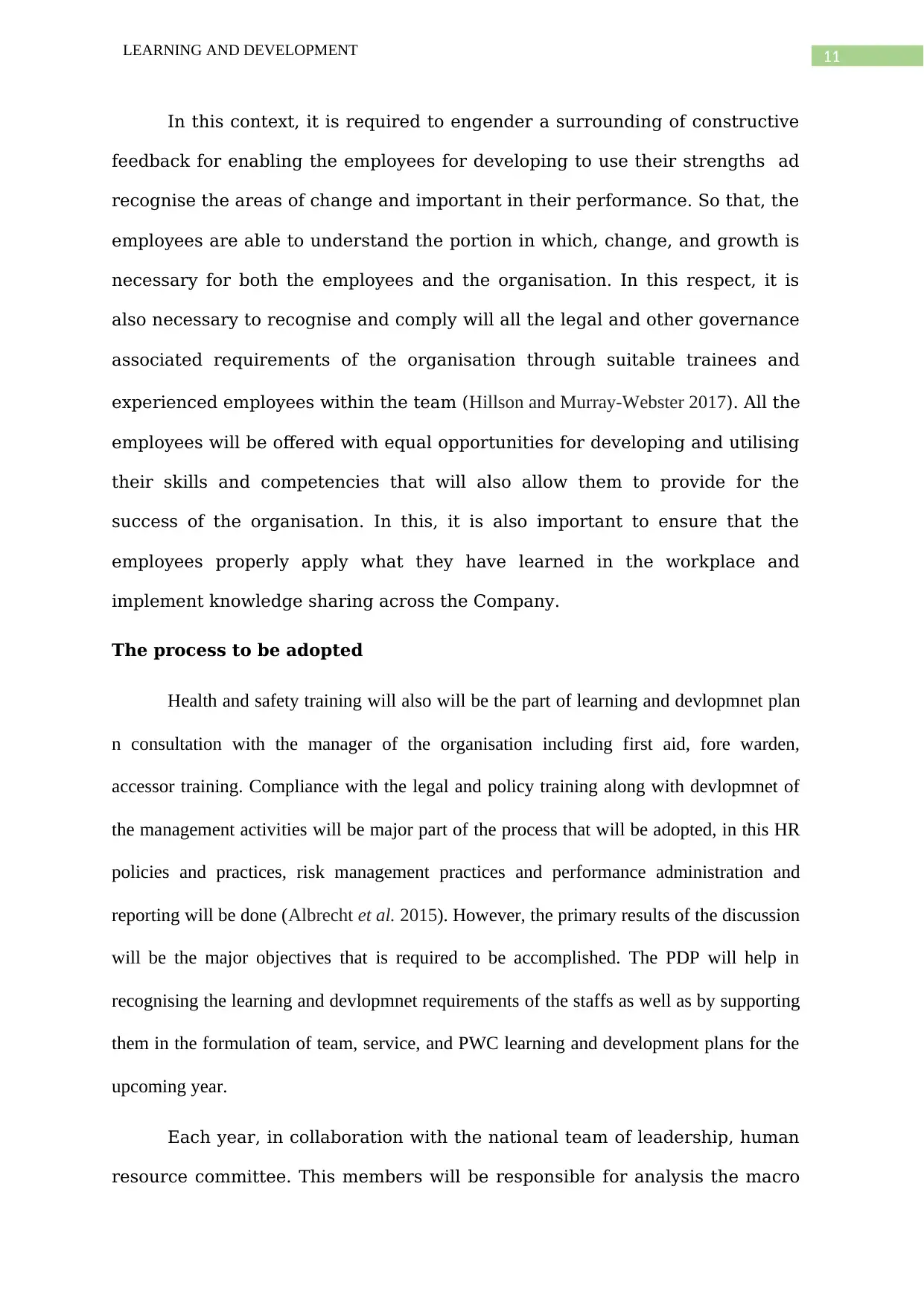
11LEARNING AND DEVELOPMENT
In this context, it is required to engender a surrounding of constructive
feedback for enabling the employees for developing to use their strengths ad
recognise the areas of change and important in their performance. So that, the
employees are able to understand the portion in which, change, and growth is
necessary for both the employees and the organisation. In this respect, it is
also necessary to recognise and comply will all the legal and other governance
associated requirements of the organisation through suitable trainees and
experienced employees within the team (Hillson and Murray-Webster 2017). All the
employees will be offered with equal opportunities for developing and utilising
their skills and competencies that will also allow them to provide for the
success of the organisation. In this, it is also important to ensure that the
employees properly apply what they have learned in the workplace and
implement knowledge sharing across the Company.
The process to be adopted
Health and safety training will also will be the part of learning and devlopmnet plan
n consultation with the manager of the organisation including first aid, fore warden,
accessor training. Compliance with the legal and policy training along with devlopmnet of
the management activities will be major part of the process that will be adopted, in this HR
policies and practices, risk management practices and performance administration and
reporting will be done (Albrecht et al. 2015). However, the primary results of the discussion
will be the major objectives that is required to be accomplished. The PDP will help in
recognising the learning and devlopmnet requirements of the staffs as well as by supporting
them in the formulation of team, service, and PWC learning and development plans for the
upcoming year.
Each year, in collaboration with the national team of leadership, human
resource committee. This members will be responsible for analysis the macro
In this context, it is required to engender a surrounding of constructive
feedback for enabling the employees for developing to use their strengths ad
recognise the areas of change and important in their performance. So that, the
employees are able to understand the portion in which, change, and growth is
necessary for both the employees and the organisation. In this respect, it is
also necessary to recognise and comply will all the legal and other governance
associated requirements of the organisation through suitable trainees and
experienced employees within the team (Hillson and Murray-Webster 2017). All the
employees will be offered with equal opportunities for developing and utilising
their skills and competencies that will also allow them to provide for the
success of the organisation. In this, it is also important to ensure that the
employees properly apply what they have learned in the workplace and
implement knowledge sharing across the Company.
The process to be adopted
Health and safety training will also will be the part of learning and devlopmnet plan
n consultation with the manager of the organisation including first aid, fore warden,
accessor training. Compliance with the legal and policy training along with devlopmnet of
the management activities will be major part of the process that will be adopted, in this HR
policies and practices, risk management practices and performance administration and
reporting will be done (Albrecht et al. 2015). However, the primary results of the discussion
will be the major objectives that is required to be accomplished. The PDP will help in
recognising the learning and devlopmnet requirements of the staffs as well as by supporting
them in the formulation of team, service, and PWC learning and development plans for the
upcoming year.
Each year, in collaboration with the national team of leadership, human
resource committee. This members will be responsible for analysis the macro
⊘ This is a preview!⊘
Do you want full access?
Subscribe today to unlock all pages.

Trusted by 1+ million students worldwide
1 out of 26
Related Documents
Your All-in-One AI-Powered Toolkit for Academic Success.
+13062052269
info@desklib.com
Available 24*7 on WhatsApp / Email
![[object Object]](/_next/static/media/star-bottom.7253800d.svg)
Unlock your academic potential
Copyright © 2020–2025 A2Z Services. All Rights Reserved. Developed and managed by ZUCOL.





